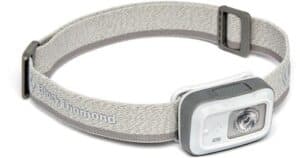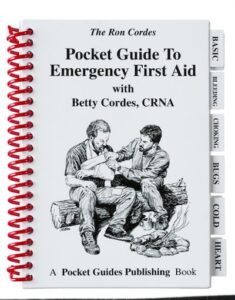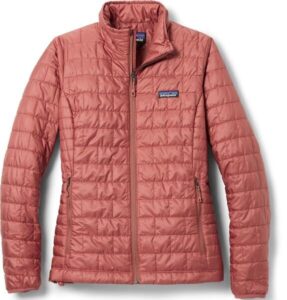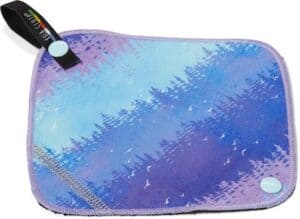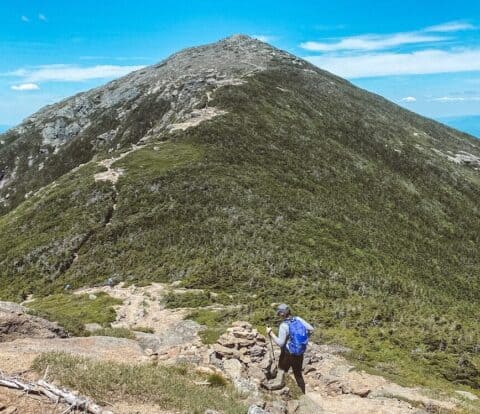Wondering what to pack for your day hike and feeling overwhelmed? Hiking is my absolute favorite way to spend a day, but packing for a hike can be a tricky thing. Over the years I’ve made lots of mistakes when it comes to packing for a day hike. Thankfully, after tons of trial and error (and loads of research) I’ve zeroed in on the most important items to pack for a day hike, and put together this handy guide.

Whether you’re an experienced hiker or headed out on your very first trail, these are the most important essentials you need to bring when packing for a day hike.
Don’t forget to sign up for my newsletter and receive a free PDF download packing list to check before your next hike, and never hit the trail unprepared again!
This post contains some affiliate links, which means if you buy something, my blog will receive a small commission at no extra cost to you. I will never recommend products or links on this blog that I have not personally used or fully endorse.
Finding the Right Pack for A Day Hike

Before we start on what to pack for a day hike, you’re going to need the right hiking daypack.
Choose a daypack that can hold all your essentials, including extra food and water, rain gear, and warm layers (more on all of those below). For the average day hike between 3 and 10 miles, pick a pack that has at least an 18L capacity, pockets for water bottles or a hydration reservoir, and hip and sternum straps for support.
Looking for some suggestions for the perfect daypack? Check out my guide to findingThe Best Hiking Backpacks and Daypacks for Women. 90% of the time, I use my Osprey Tempest 20L daypack.
Understanding the 10 Essentials When Packing for a Day Hike
With the perfect hiking pack selected, the obvious next question is what do you pack inside? Hikers refer to the essential items that you should absolutely pack on every hike as the “Ten Essentials.”
The “Ten Essentials” were developed by The Mountaineers, a Seattle based organization dedicated to helping climbers and hikers. The list formally debuted in 1974 and included items like a compass and matches. Since then, the list has evolved to a “systems” approach, instead of checklist of individual items.
The purpose of the 10 Essentials list is to 1. Prevent and properly respond to emergencies on the trail and 2. Allow you to safely survive a night (or more) outside if necessary.
Think this is overkill? Unfortunately, a recent study says that about 90% of hikers requiring Search and Rescue assistance are day hikers, most of whom became lost when accidentally wandering off trail.
So, what are the 10 Essentials?
The “10 Essentials” to Bring on Every Hike
- Navigation
- Illumination
- Sun Protection
- First Aid Kit
- Gear Repair – Knife, Multi tool, repair tape
- Fire
- Emergency Shelter
- Food – and a garbage back to pack it out.
- Water
- Extra Clothing
Okay, if that list looks like I’m telling you to pack everything but the kitchen sink, don’t panic!
Each of the 10 Essentials serve an important function, so lets dive deep into the 10 Essentials, plus a few more items that I always consider when packing for a day hike.
Navigation
Never assume that you’ll have cell service on the trail. Know where you’re going by downloading a map ahead of time using a GPS-based app like AllTrails Pro or Gaia GPS subscription.
Of course, relying on your phone for GPS is not always reliable. For longer hikes, or areas where you frequently hike, I always recommend investing in a topographic trail map.
If you plan on heading into the backcountry or a less developed trail system, knowing how to use a compass and map is an invaluable skill.
Ready to learn more? Many outdoor retailers like REI offer basic navigation classes.
Illumination
Getting caught on the trail after dark happens all too frequently. Be prepared when packing for a day hike with a light source such as a flashlight, or better yet, a headlamp to find your way after the sun goes down.
Don’t forget to check the batteries on your flashlight or headlamp before you head out.
Sun Protection
Sun protection is a MUST year-round. This is especially true in the mountains where UV radiation is stronger, and snow reflects sunlight exceptionally well. Sunburn is very possible, even on a cloudy day.
To protect your skin, bring a bottle of sunscreen that is at least 30 SPF, and reapply regularly. Make sure to also pack sunglasses, and a brimmed hat.
First Aid
Accidents happen even to the most prepared hiker. I’ve suffered plenty of sprains, cuts, scrapes and bruises on every type of trail. That’s why a fully stocked first aid kit is one of the most important things to remember when packing for a hike.
A complete hiker’s first aid kit should include the following:
Adhesive bandages (In multiple sizes)
Gauze pads
Antiseptic Wipes
Antibacterial Ointment
Medical tape
Blister Treatment
Ibuprofin/Pain Reliever
Aspirin (for a response to a heart attack)
Antihistamine for allergic reactions – Get and carry a prescription EpiPen if you have a known allergy!
Tweezers
Rolled elastic bandage for sprains
Surgical gloves
Hand sanitizer
Don’t forget any prescription medications, as well as a waterproof bag to keep it organized in your pack.
Packing on a budget? Most first aid items can already be found in your home. Package them in a gallon plastic or reusable silicone bag.
Make sure to always label any medication, such as ibuprofen or antihistamine such as Benadryl and include the dosage of each pill (usually in mg).
I also carry a Pocket Guide to Emergency First Aid that covers common scenarios like sprains, bone injuries, heat and cold injuries, and snake bites.
Hiking with your dog? Don’t forget to include first aid for your four-legged best friend too! Adventure Medical Kits’ “Me and My Dog” kit includes everything both you and your dog might need during common hiking emergencies.
All hikers (and everyone, really) should consider a first aid and CPR course, often offered by organizations like the American Red Cross. If you plan on spending time in the backcountry, consider a wilderness focused first aid course offered through NOLS, the National Outdoor Leadership School.
Gear Repair and Knife
Even the best gear can rip or break, and usually at the most inconvenient time. Bring some repair items to keep your gear in one piece, at least until you can get back to your car. I use a small roll of duct tape, and a multi-tool.
Along the same lines, I always recommend packing a small knife, or bringing a multitool with a knife function. The knife is useful for first aid, gear repair, and yes self-defense, especially when solo-hiking.
Fire Source
While it’s unlikely that you’ll need to start a fire (and in some places it may be illegal to do so) – having a source of heat in severe cold conditions or in an extended emergency can be a lifesaving skill.
An inexpensive stormproof match kit or a lighter takes up very little room and weight in your pack. Just make sure that your matches or lighter are stored in a waterproof bag or container.

Emergency Shelter
Temperatures can drop dramatically overnight or during a winter storm. Always carry an emergency shelter in the event that you become injured or lost and have to spend a night outside. When packing for a day hike, carry a simple emergency blanket or bivvy (essentially a thin sleeping bag).
These emergency shelters are cheap, lightweight, and roll up smaller than a can of soda.
Whatever you bring, make sure it is waterproof and heat reflective so that it radiates your body heat back to you and prevents heat loss.
Food
Avoid getting hangry with your hiking companions and bring plenty of calorie-rich food to sustain your energy for a long day of hiking.
I commonly bring bars, like ClifBar, Kind bars, or RxBars, as well as dried fruit and nuts, or fresh fruit like apples and oranges. Don’t forget to pack out all of your trash, including apple cores and orange peels, as a part of practicing good Leave No Trace principles.
Water
Hands down, the most important item to bring on any hike is plenty of water. How much?
You should carry at least ½ liter of water for every half hour of hiking. More if your hike is strenuous or in hot conditions.

For short hikes, a lightweight reusable water bottle can get the job done. For long hikes, invest in a hydration reservoir (also called a water bladder). Reservoirs come in multiple sizes ( I recommend a 2L or 3L size, depending on your needs) and fit inside a sleeve in your day pack. A tube runs from your reservoir to the front of your pack, giving you easy access to water without breaking your stride.
Don’t forget to properly clean and dry your hydration reservoir.
I also recommend carrying a lightweight water filtration device, like the Sawyer Squeeze or Lifestraw, to refill your water supply from natural sources like streams and lakes. Unfiltered backcountry water can contain harmful bacteria that can result in serious illness.
Extra Clothing

Weather can change quickly in any season, so I recommend always bringing an extra warm layer of insulation. A down jacket or lightweight fleece will keep you warm when temps drop without adding too much weight to your pack.
If you live in an area that is prone to sudden rainstorms (hellooo, living in the South!) make sure to always pack a rain jacket, even if the forecast only calls for a slight chance of rain. Is rain in the forecast? Consider wearing rain pants, waterproof boots, and bring an extra pair of socks.
In summer I stick to my North Face Venture rain jacket as my extra layer. In other seasons, I always bring an insulated jacket, like my Patagonia Nano Puff, or a fleece.
Hiking in Winter? Check out my complete guide to winter hiking, including what to wear when hiking in cold weather.
What Should I Wear on a Hike?
Choose hiking clothes that are quick drying and moisture-wicking to pull sweat away from your body and keep you dry. Avoid cotton and denim clothing, which take a long time to dry and pull heat from your body.
Women’s Hiking Shirts
Women’s Hiking Pants and Shorts
Beyond The Essentials: More Important Items to Pack for a Day Hike
After packing your ten essentials, there are a few more important items that I always like to include when packing for a day hike. Some of these extras depend on when and where you hike. Consider how long you plan on hiking, the trail conditions, and how heavy you want your pack to be.
What to Pack for a Hike to Bear Country
If you’re hiking in an area where bear encounters are common, especially in grizzly country (Montana, Wyoming, Idaho), I strongly recommend carrying bear-spray.
Bear-Spray works like pepper spray and is a non-lethal defense formulated for use against an aggressive bear. Remember to keep your bear spray easily accessible in a holster (bear encounters happen FAST) and not in your pack.
Planning a trip to Yellowstone, Grand Teton or any other bear country hikes? Check out this video from the National Park service on bear spray.
Bug Protection
Depending on your location, bugs including mosquitos, ticks, and black flies can have a huge impact on your hike!
In the Northeast US, black flies swarm from late spring to early summer, and many hikers wear head nets or just avoid the trails all together. In the Southeast, mosquitos are vicious from spring until fall. And in Alaska, the mosquitos are so fierce, they are un-affectionately called the “Alaska State Bird.”
It helps to research what bugs are present in your particular area, or even particular trail and be prepared.
As someone who has some kind of invisible “All You Can Eat Buffet” sign above my head that only mosquitos can see, I use repellant sprays with DEET or Picaridin. Some hikers prefer a DEET-free spray made with essential oils such as lemon and eucalyptus.
If you expect bugs to be particularly bad, consider adding a head net over a wide-brimmed hat when packing for your hike. It may not be the coolest look – but it’s better than wiping bugs out of your eyes for hours! 😳
When Nature Calls – Going to the Bathroom Outdoors
At some point, nature is going to call when you’re out on a hike. While some trails have toilets at the trailhead, you won’t always find toilet paper or a sink. Practice good hygiene and Leave No Trace by bringing a few necessary essentials to do your business.
If you were assigned male at birth, well then going #1 while outdoors is pretty straightforward. For women, a small pack of tissues makes good toilet paper (just make sure to pack it out!), or better yet try a reusable antimicrobial pee cloth, like Kula Cloth.
Deposit solid waste – you know what I’m talking about – into a cathole at least 6″ deep. A lightweight trowel will help you dig in most conditions. Make sure your cathole is at least 200 feet from water, camp sites, or the trail.
Finally, make sure to use plenty of hand sanitizer before and after.
Trekking Poles
While not every hiker likes to bring trekking poles, I bring them on most strenuous hikes! Trekking poles help relieve pressure on your knees during steep ascents and descents and provide extra stabilization.
There are tons of options for trekking poles at different price points. Learn more about how the choose the perfect trekking pole here.

Summit Beer
Ok, this one is definitely optional. But is there anything more satisfying than enjoying a well earned beer at the top of the mountain you just climbed?
Drink responsibly, of course, and pack out your can when you leave.
Download Your Printable PDF Guide to Packing for a Day Hike
So, there you have it! With these essentials, plus some creature comforts you’re prepared for the trail. While it may seem like a lot, adequately packing for a day hike can mean the difference between an enjoyable or miserable experience outdoors. And in extreme situations, it can mean the difference between life and death.
Even the most experienced hikers can forget some of these items. That’s why I created my easy printable checklist to make sure I’m fully prepared each time I step on the trail. Don’t forget to get your download by clicking the link below!
Pin Me For Later




